Abandoned cart emails aren’t a new concept to experienced ecommerce marketers—because they work.
Klaviyo’s product analytics team analyzed over 143K abandoned cart flows sent in 2023 to gather data on abandoned cart open rates, click rates, revenue per recipient (RPR), and more.
What they found is that by bringing shoppers back to complete a purchase, abandoned cart flows make you money—more than any other automated flow that you set up.
But to see those results, you need to carefully plan, create, and test the ideal abandoned cart flows for your brand. And while every brand is different, we’ve determined these 12 best practices are must-haves to see great results.
If you need to, come back to this article after reading about the basics of abandoned cart emails.
1. Start with understanding why your shoppers abandon their carts
Think through your customer’s experience. When they’re shopping on your website, what’s the most likely reason they abandon their cart?
A meta-analysis by the Baymard Institute found that nearly 48% of shoppers ditch carts because they’re either “just browsing” or “not ready to buy.” But when they excluded this segment of people, they also found that people don’t buy because:
- Shipping and other fees are too high.
- The online store asks them to create an account.
- They don’t trust the website with their credit card information.
- The product delivery estimate is too slow.
- The returns policy isn’t satisfactory.
- There aren’t enough payment methods.
2. Personalize abandoned cart emails based on purchase history, cart size, and product preferences
Before you start crafting the content of your abandoned cart emails, make sure you understand and implement trigger splits and conditional splits.
Similar to customer segmentation, adding splits to your flows allows you to personalize your abandoned cart email messaging based on event and profile data such as purchase history, cart size, and product preferences.
“Sometimes, the best way to turn a missed sale into a conversion is by highlighting items a shopper may have missed,” says Sharon Goldstein, CEO of LimeSpot.
“Including personalized product recommendations in an abandoned cart email can turn heads and drive much higher click rates as shoppers investigate new finds that align with what they’ve already shown an interest in,” Goldstein explains.
In this abandoned cart email, DTC grooming brand Beardbrand does a great job following this advice. Notice how they not only use personalized copy and a friendly tone to inspire shoppers to “reclaim” their cart, but also keep the product front and center, with distinct CTAs to draw the recipient’s eye:
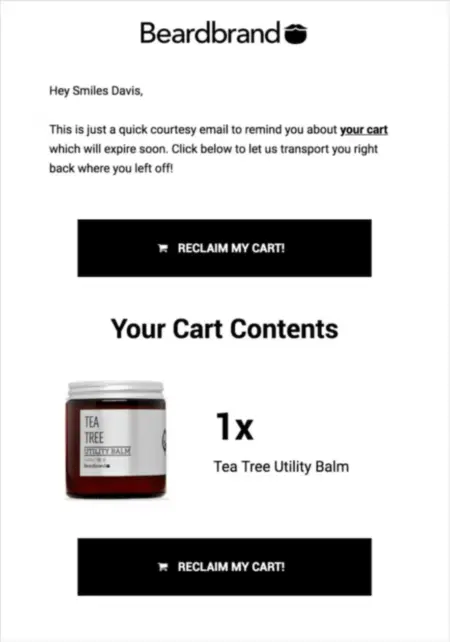
The challenge with abandoned cart personalization is that there’s no one-size-fits-all strategy. Analyze your performance periodically to find the best approach.
It’s also important to filter out everyone who has abandoned a cart recently. Hitting these inboxes too frequently can annoy subscribers and increase opt-out rates.
3. Send multiple emails as part of an abandoned cart flow—but test it first
A cart abandonment email doesn’t have to be an isolated message. You can also create an abandoned cart series.
A simple abandoned cart email sequence might look something like this:
Remind customers about the products in their cart.
Send a follow-up email with a discount.
Email marketing pro Chase Dimond shares that in his experience, “having multiple abandoned cart emails results in 69% more orders than a single abandoned cart email.” But every brand is different, so always A/B test this for yourself.
4. Personalize your subject line to fit the customer’s profile
The easiest way to grab attention with an abandoned cart email is by personalizing subject lines using customer profile properties like first name or the products they left their cart.
Something as simple as “Hey Alex, where’d you go?” or “Stay hydrated with the bottles you left behind” can work wonders for your flow performance.
If you aren’t using profile properties for email personalization, you can use something simple yet conversational to grab customer attention instead. Watch how jewelry brand Uncommon James gets a shopper’s attention:

5. Align your email copy to your brand voice
An abandoned cart email’s objective is to nudge shoppers toward a purchase. Keep your email copy short and limit punctuation, but don’t shy away from your brand’s tone and voice so that customers can get to know you through your abandoned cart email.
In this abandoned cart example, sustainable activewear brand Girlfriend Collective uses a minimalistic email template with clever copy: “Looks like you left something cute and sustainable in your cart. Don’t worry, we saved it for you.”
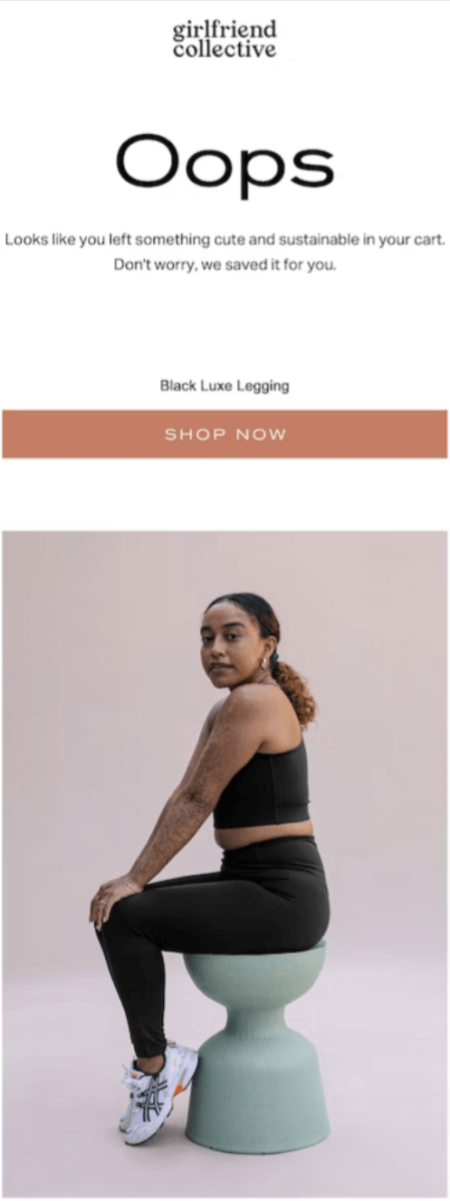
“This abandoned cart email from Girlfriend Collective is *chef’s kiss,*” says Alex McPeak, content strategist at Klaviyo, on Twitter. “I love the deviation from ‘you forgot something/left something behind’ with ‘you dropped this’ and how they hammer home the sustainability aspect, which is core to their brand.”
6. Feature high-quality product shots of the abandoned product
By the time shoppers see your email, a million other thoughts could be consuming their mind—and your product won’t be a priority. To entice recipients to engage with your product page again, you’ll need to make it look really good with a high-quality product shot.
In this cart abandonment email, apparel brand Alex Mill uses most of the available real estate to highlight abandoned items with high-quality product images, then complements those with an enticing discount to drive conversions.
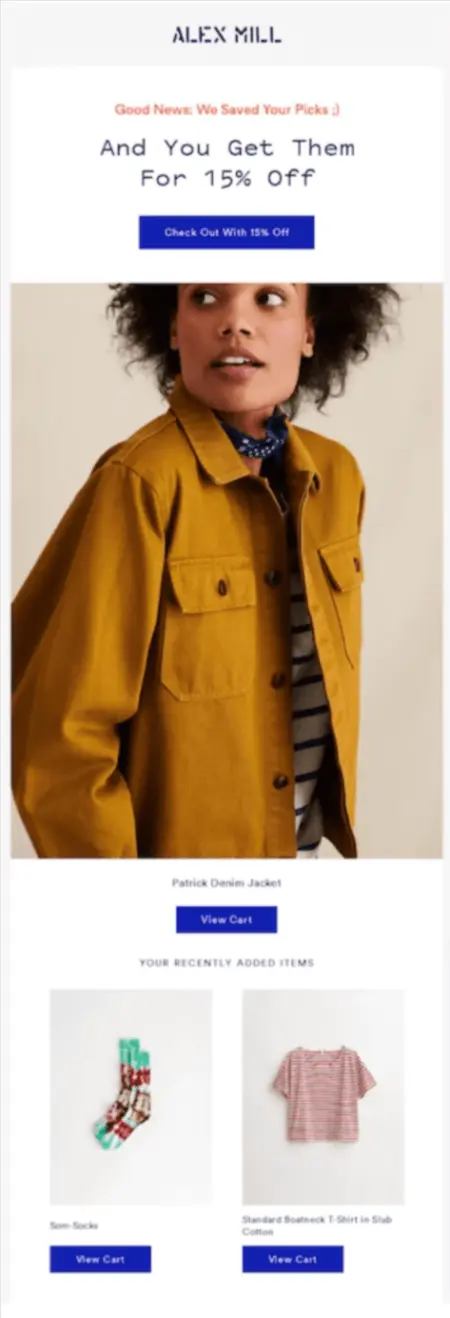
7. Mix in some social proof
Social proof can influence buying decisions by communicating your products’ value through user-generated content (UGC). More importantly, it can help you earn the trust of shoppers who aren’t familiar with your brand.
Customer testimonials and reviews are a great place to start. But you can also include star ratings and even social media mentions to convey authenticity and build trust.
This cart abandonment email from Kim Kardashian’s shapewear brand, SKIMS, uses both star ratings and customer reviews:
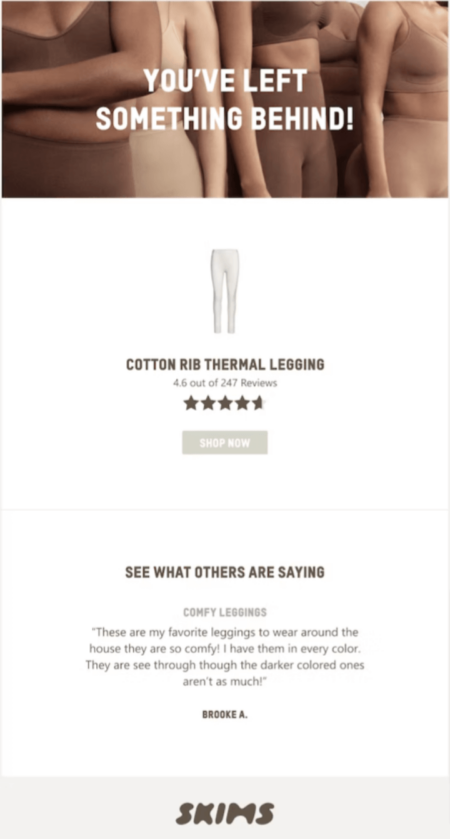
8. Offer discount codes…
Personalized and limited-time discounts are a timeless strategy for creating a sense of urgency and increasing conversions in an abandoned cart flow. After all, who doesn’t love a good bargain?
The added benefit of offering a coupon code to abandoners is that it doesn’t reduce the value of your brand upfront.
A word of caution: Offering discounts to repeat cart abandoners can work against you by training them to wait for a discount before buying. One way to overcome that is by providing one-off discounts like health and beauty brand Golde does for new customers:
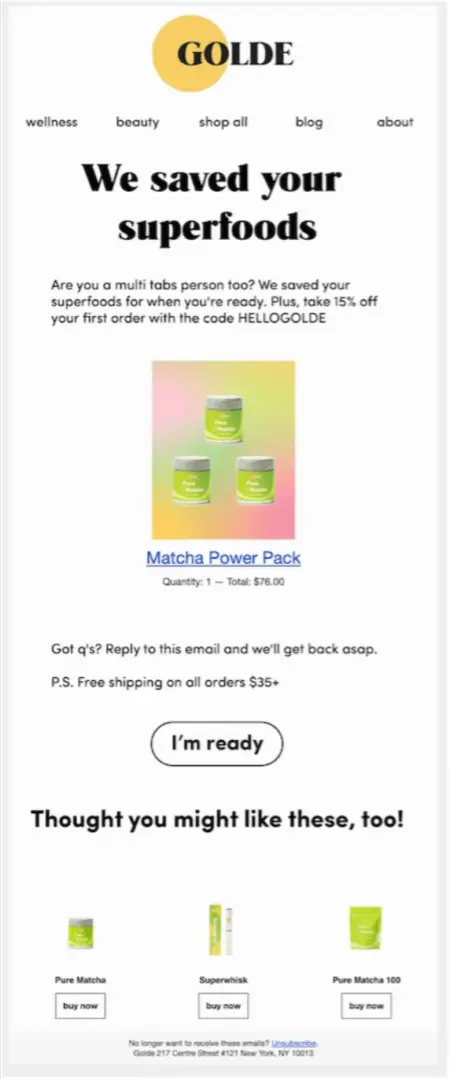
And if it really doesn’t make sense for your business economics to be throwing around discount codes for every abandoned cart, consider segmenting high-value carts and only offering an incentive on those where you stand to make more revenue from a single purchase.
9. …or consider offering free shipping instead
According to Baymard, the reason almost half of cart abandoners walk away is that extra costs, like shipping, are too expensive.
It stands to reason, then, that offering free shipping may push them over the line to purchase.
Belle Murray, ecommerce senior strategist at SmartBug Media, suggests this strategy as a way to do more than simply remind your customers that they left without buying: “Introduce a free shipping offer toward the end of your abandoned cart automation.”
“Shipping cost is a very common reason customers leave before completing their purchase,” Murray explains. “A one-time free shipping offer is a great way to give them a nudge to place their first order. Keeping it at the end of your automation with engagement filters will help target engaged subscribers that are still on the fence about purchasing.”
Here, hair and bodycare brand Rudy’s offers free shipping to cart abandoners, highlights the offer at the very top, and includes a clear message about the offer’s urgency.

10. Use a convincing CTA
The call to action (CTA) is one of the most important parts of your cart abandonment email. It gives your customers clear instructions about what they need to do next—return to their cart and complete their purchase.
Some traditional, clear CTAs for abandoned cart emails include:
- Buy now
- Shop now
- Keep shopping
- Return to cart
- Proceed to checkout
- Finish checking out
- Check out now
- Complete your order
If you’re offering a discount or free shipping to get someone back to their cart, consider making that the CTA:
- Activate free shipping
- Get my 10% off
- Reveal new price
If your brand wants to come off a little softer, consider a less aggressive CTA for your abandoned cart email:
- Take a closer look
- View cart
- Take another look
If your brand’s voice is cheeky or conversational, now is a great time to have fun with the CTA:
- Let’s do this
- Finish the job
- Seal the deal
- Treat yourself
11. Send your email 2-4 hours post-abandonment
Timing your emails correctly is always crucial to success—and nowhere is that more true than the abandoned cart flow.
Don’t send an email too soon after your customer abandons their cart. Whatever distracted them from their purchase might still exist. And if it does, your email might end up buried deep in their inbox or straight in the trash.
Send your first reminder 2-4 hours after abandonment, and keep it simple. You want it to feel organic and friendly.
If your customers don’t engage with your first email, consider sending another reminder 24-48 hours after that. You can make the second reminder a bit more salesy, or work in a personalized offer to amplify its impact.
If shoppers don’t respond to 2-3 emails, they’ve likely completed their purchase somewhere else or abandoned it entirely.
At this stage, sending a third sales-oriented email might not help. Instead, send an exploratory email to suggest popular items or related products and lay the foundation for a future sale.
12. Incorporate SMS in your abandoned cart flows
For a high-intent flow like abandoned cart, SMS is often a great channel for adding urgency to the communication. You can complement an abandoned cart flow with SMS to make sure you’re communicating with your audience on the channel they prefer most.
If you’ve collected your customers’ phone numbers and SMS consent, send a quick text reminding them about the products they left behind. That might be the push they need to follow through with their purchase.
Important note: If you are sending abandoned cart texts to US recipients, you must adhere to the following requirements:
- Use double opt-in when collecting SMS consent.
- Only send 1 SMS per recipient.
- Send the text within 48 hours of someone abandoning a cart.
How to set up an abandoned cart flow in Klaviyo
Setting up an abandoned cart flow in Klaviyo is simple. Before getting started, make sure your ecommerce platform is integrated with Klaviyo.
Step 1: Choose a pre-built abandoned cart flow from the flows library. Don’t worry, you can always customize it later. You can also create an abandoned cart flow from scratch.
Step 2: Determine how long you want to wait to send the abandoned cart email after the shopper abandons their cart.
Make sure you’re giving your customers enough time to complete their purchase. In other words, don’t set this flow to send after half an hour. The shopper may have just stepped away.
We recommend sending that first email 2-4 hours after someone starts a check-out. But if you sell big-ticket items, like mattresses, you may want to leave more time for more consideration.

Step 3: Decide how many emails you want to include in your abandoned cart flow. We recommend sending 2-3.
Step 4: Craft the content of your abandoned cart emails.
Step 5: Set your flow live and add past profiles if you desire.
Abandoned cart email FAQs
When to send an abandoned cart email?
To maximize the chances of user re-engagement, users should receive an abandoned cart email within 2-4 hours of abandoning items in their online carts.
How successful are abandoned cart emails?
According to Klaviyo’s 2024 Benchmark Report, abandoned cart flows drive the highest average RPR ($3.65) and the highest average placed order rate (3.33%) of all flows.
What is the best abandoned cart email sequence?
The best abandoned cart email sequence differs from brand to brand based on a wide variety of factors, and we always recommend A/B testing to determine what works for you. But if you’re looking for somewhere to start, we recommend the following sequence:
Remind customers about the products in their cart.
Send a follow-up email with a discount or free shipping offer.
Share a product recommendation or ask for customer feedback.



